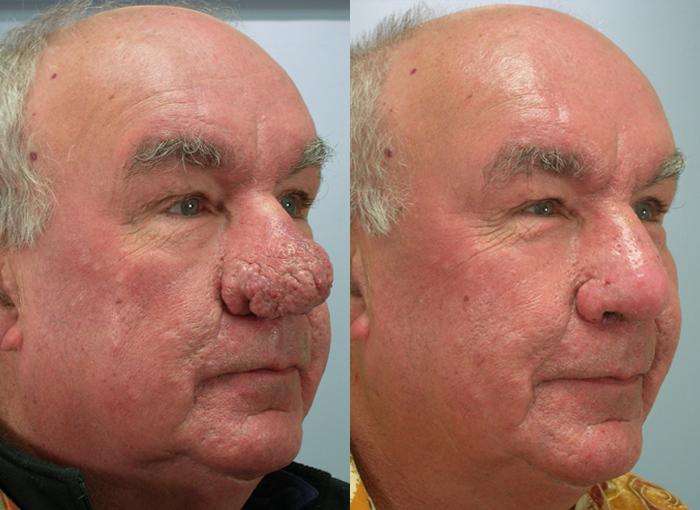
Rhinoplasty can correct many nasal issues, but not all of them. Rhinoplasty involves reshaping the nasal bones and cartilages to improve the nasal appearance or improve nasal breathing. However, rhinoplasty does not affect the nasal skin. Rhinophyma is a condition of the nasal skin that is characterized by sebaceous gland hyperplasia. This condition was once thought to be due to alcohol consumption, but this is not true. Rather, it is a particularly severe form of rosacea that affects the nasal skin. The overgrown sebaceous tissue gradually accumulates over years to decades, and can result in a severe lobulated and bulbous appearance of the nose. This overgrown tissue can even become so severe that it impacts nasal breathing. When the condition is in its early stages, it can be slowed down by aggressive topical treatments including antibiotics, isotretinoin, and other acne treatments. However, once significant tissue overgrowth has occurred, the only effective treatment is surgery.
Rhinophyma Surgery
Surgery to correct rhinophyma is primarily a skin-resurfacing procedure. The normal nasal structure exists underneath the bulky glandular tissue, so the goals of the procedure are to remove the excess tissue and recontour the nose to its original form. This procedure has been described with a myriad of surgical techniques, including scalpel excision, electrosurgery, dermabrasion, laser resurfacing, and skin grafting. We have seen the best results with a combination approach involving scalpel excision, dermabrasion, and the CO2 laser. The first step is to remove any bulky tissue with a scalpel. This is followed by dermabrasion, and in this step the dermabrader is used to “sand” down the residual tissue to fit the normal nasal contour. The final step is CO2 laser resurfacing, and this helps precisely refine the nasal contour and “seal” the area.
Rhinophyma Excision
Rhinophyma excision is typically performed in the operating room under general anesthesia, and the procedure takes approximately an hour and a half to perform. Discomfort is relatively mild afterward. People do have to moisturize the area and wear a bandage over the nose for the first week after surgery, in order to facilitate healing of the nasal skin. The procedure is very effective at restoring the nasal contour and appearance, but it does not address the cause of the condition. Therefore after surgery, people are strongly encouraged to begin a skin care regimen aimed at preventing recurrence of the condition. That being said, significant rhinophyma typically develops over decades, and people usually do not require a second procedure.
Rhinophyma Surgery Risks
Risks of the procedure, similar to other skin resurfacing procedures, include hypopigmentation of the nasal skin. This is typically a small risk, but is more common in individuals with darker skin or those who tan easily. Another risk involves viral infection of the skin as it is healing, and this is avoided with preoperative antiviral medications. Yet another risk is cartilage exposure with resulting nostril retraction, and this is avoided with careful and meticulous surgical technique. When done well, rhinophyma excision is a transformative experience for the patient, and it is one of the most gratifying procedures for the Facial Plastic Surgeon.
